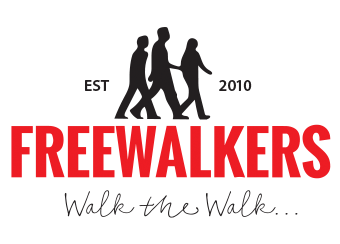What to Expect and How To Prepare
These are general questions and answers that will help you prepare for a FreeWalkers event. For additional questions please email us at: info@freewalkers.org
What should I bring with me?
These are only general recommendations. Our walks vary a lot so what to bring will be different for each walk and is often personal preference as well.
Hydration: Everyone’s body is different, and how much hydration to bring will depend on the total mileage and the range of temperatures for the day. Please do not depend on refilling or buying drinks, unless you are sure of this in advance. It’s always better to have more than less. Additionally, we recommend beginning the hydration process the day prior to each walk as well as the day after for replenishment purposes.
Hat & Gloves: A cap with a brim for sun protection and/or ear coverage in cold weather. Always have gloves in cold weather. Hand warmers are helpful in very cold weather.
Food: Everyone has different dietary preferences and needs, so bring with you what you feel will sustain you for several hours (e.g. snack bars, trail mix, PB sandwiches). On some walks, there may be options to buy snacks but unless specified it is best to carry what you prefer.
Cell Phone/ID: Be sure to have a fully charged phone (and back-up battery), wallet, credit/debit card and yes, some cash is a good idea.
Carrying Pack: In variable temperatures a pack is good to be able to add or shed layers and put them away. Also good to have your hands free, so a sling pack, waist or backpack is suggested. Again, the size is a personal choice and depends on what you choose to carry, and we recommend that everyone be mindful of how much weight you commit to carrying for the distance/time of each particular walk.
Clothes: What you wear/carry depends on the weather conditions. The general recommendation is to layer with wear wicking fabrics. Wicking fabrics are poly/wool/silk or other blends. Cotton is generally NOT recommended as it absorbs moisture in both hot and/or cold temperatures which will keep you sweaty in summer and colder in the winter.
Extra Socks: (optional) extra pair of socks to change into if needed. Also, some kind of blister application, Band-Aids and/or Body Glide (apply this ahead of time to prevent blisters).
Miscellaneous: GPS tool, watch, sunscreen, insect repellant, flashlight/headlamp for walking after sunset, hiking poles for trails and traction devices for ice/snowy conditions.
Emergency Contact information: Please have this with you in case we need to contact someone on your behalf.
How will I feel after a long walk?
A combination of hours on your feet and your body constantly moving may take a toll on you. Even if you’ve done everything right, you may feel tired and sore following a long day of walking. For a quicker recovery, we recommend tending to your body the day prior to the walk by drinking plenty of fluids and eating proper meals that will sustain you the following day (everyone is different so the amount to eat/drink depends on you). Also make sure to eat and drink after the walk. You also can do some gentle body stretches, then rest and elevate your feet. Additionally, if you are driving in a car or sitting on a train after your walk, be mindful when you sit and stand up. Your muscles may be stiff and/or your body may be dehydrated, so just be careful.
What is the best shoe for walking?
The first line of defense for a successful walk is to have a good pair of walking shoes. Often, folks ask, “What is the best shoe for walking?” The answer is: There is no one best shoe for all. Our feet are as varied as the many brands and styles of shoes to choose from. Do your homework, ask questions, experiment and when you find what works for you, you will know it and likely stick with it.
A good place to shop for shoes is physical athletic stores where you can buy, wear and return/exchange what doesn’t work for you. Investigate which stores will accept returns, provide a store credit, or a full refund.
Once you identify your favorite shoe you can shop anywhere for it. One tip for athletic shoes is to consider a half-size larger than your normal shoe size. This allows for different thickness of socks, swelling feet and room to move your toes, all of which are important.
How do I prevent blisters?
Blisters are common, and it never hurts to be prepared. While there are no guarantees you will not get blisters even with the best preventative strategies, you can try.
They are formed by the rubbing of your feet against socks, so you will want to reduce the friction for those parts of your feet that are susceptible to blisters. Consider prepping your feet with a lubricant, e.g., talcum powder or petroleum jelly.
Today there are great products on the market that prevent chafing; they can be found in most athletic stores and available online, and should be used in accordance with the manufacturer’s instructions. Some walkers find applying kinesiology tape to the parts of your feet prone to blisters before starting the walk is helpful. Socks that don’t move, e.g., properly size or are slightly elastic, are additional variables to investigate.
You will know if a blister is developing as your skin may feel warm and sensitive. If this starts, you may want to re-apply the treatment as soon as you can. We also recommend carrying band-aids, moleskin and gauze/tape if you choose.

